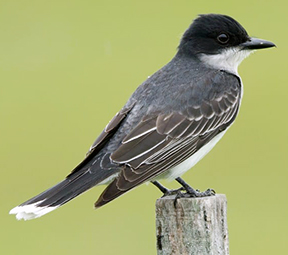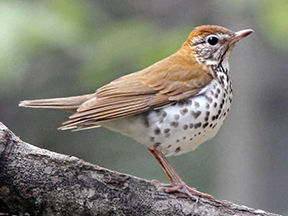Motherhouse Natural Flyway for Neotropical Migratory Birds
Posted on May 1, 2018, by Joy Jensen SL

Photo courtesy of Joy Jensen
Did you ever spot a Kentucky Warbler or a Yellow-breasted Chat? They fly freely in the Loretto Motherhouse forests. They are neotropical migratory birds that are protected under the Migratory Bird Treaty Act of 1918. A neotropical bird is defined as “a species whose breeding ground includes the North American temperate zones and which migrates south of the continental United States during nonbreeding seasons.” These birds serve as an early warning system for alterations in ecosystems and their functions. Many of these neotropical songbird populations are declining because of environmental damage and the loss of deep interior forests, which are necessary for the birds to breed. The Motherhouse farm is blessed with large tracts of deep interior forests. Large forest tracts are unusual on private lands because of environmental damage and forest fragmentation in many areas.
The Motherhouse is in the Central Hardwoods Bird Conservation Region. We are located on the Mississippi Alluvial Valley bird flyway, and we are close to the Atlantic flyway.

Photo courtesy of Joy Jensen
About 200 species of neotropical birds have been spotted in Kentucky. According to the Smithsonian’s National Zoo and Biology and Conservation Institute, these birds fly great distances from Mexico and South America because deep interior forests allow them to take advantage of seasonally abundant food. The reason migration persists is “breeding success.” The birds are able to raise more young on average by migrating than if they remain in the tropics. The abundant food, the greater area over which birds can spread and fewer predators can account for the potential to raise more young. Most of these neotropicals migrate at night when conditions are more favorable for cooler air and fewer predators, such as hawks.
Of the hundreds of birds on the Smithsonian’s conservation list, the following have been spotted in the Motherhouse forests: Red-headed Woodpecker, Wood Thrush, Kentucky Warbler, American Kestrel, Northern Bobwhite, Yellow-breasted Chat and the Chipping Sparrow. The birds on the Kentucky conservation list that have been spotted are Blue-gray Gnatcatcher, Eastern Kingbird, Indigo Bunting, Purple Martin, Scarlet Tanager, Summer Tanager and the Wood Thrush.
Our oak-hickory central hardwoods forests are precious ecosystems that provide breeding grounds and abundant food for all these neotropical migratory birds.
We are mindful of our Loretto Land Ethic as we preserve these deep interior forests. We are also faithful to our mission to preserve the forests and care for the plants, birds and animals that live in this farm ecosystem with us.
